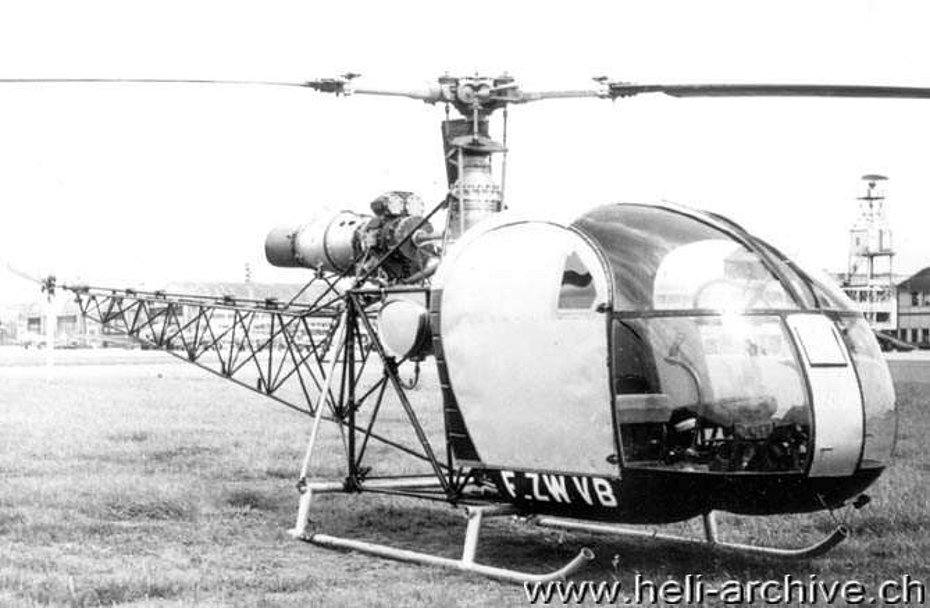
Aérospatiale SA 315B Lama - History and technical description
On 17 March 1969 the French test pilot Roland Coffignot along with the flight engineer Gerard Boutin made the first test flight with the Aérospatiale SA 315B Lama, a helicopter developed to meet the specific requirements of the Indian Army.
This article describes the history of this "mule of the air", at work for over forty years. For him the date of retirement is approaching.
Its origins
A mule of the air, so it was nicknamed by several pilots the Aérospatiale SA 315B Lama. The similarities with the sympathetic equine are numerous: both for example are hybrids (the first between a horse and a donkey, the second between the Alouette 2 and Alouette 3), also mule and helicopter are characterized by robustness, strength (power in the case of the helicopter), hardiness, resistance to hard work, great adaptability. Very briefly these are the main qualities that have earned the French helicopter the great fame and consideration that accompany him since his appearance. However commercial operations with this helicopter seem now come to an end planned by the manufacturer for the year 2020.
Although, as said, the Lama accomplished its first test flight in 1969, its origins date back to more than a decade earlier.
On 11 March 1958 Sud Est begun to test the SE 3150, an Alouette 2 powered by a Turbomeca Artouste III which had a larger main rotor, the same later used for the SE 3160 Alouette 3.
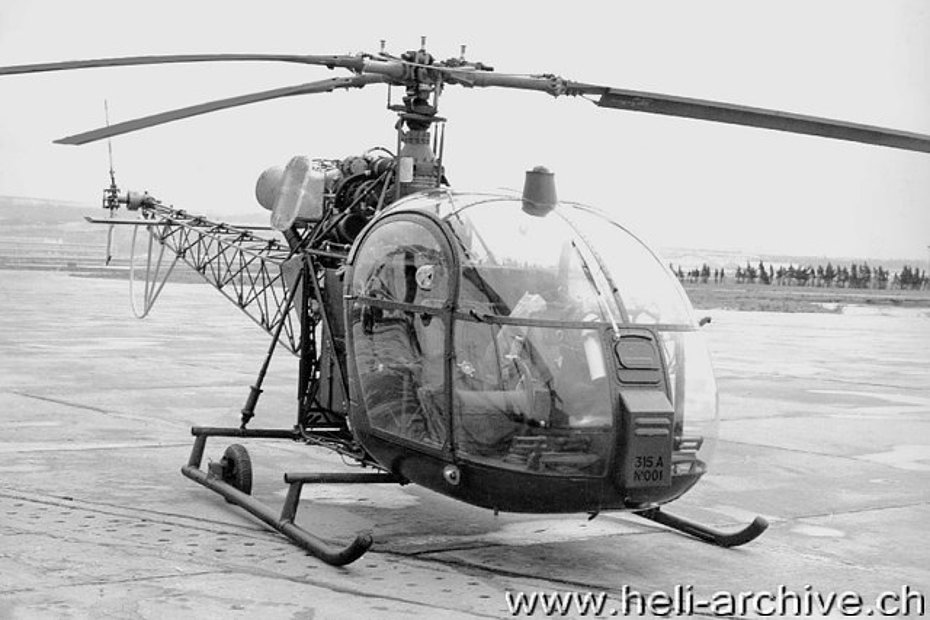
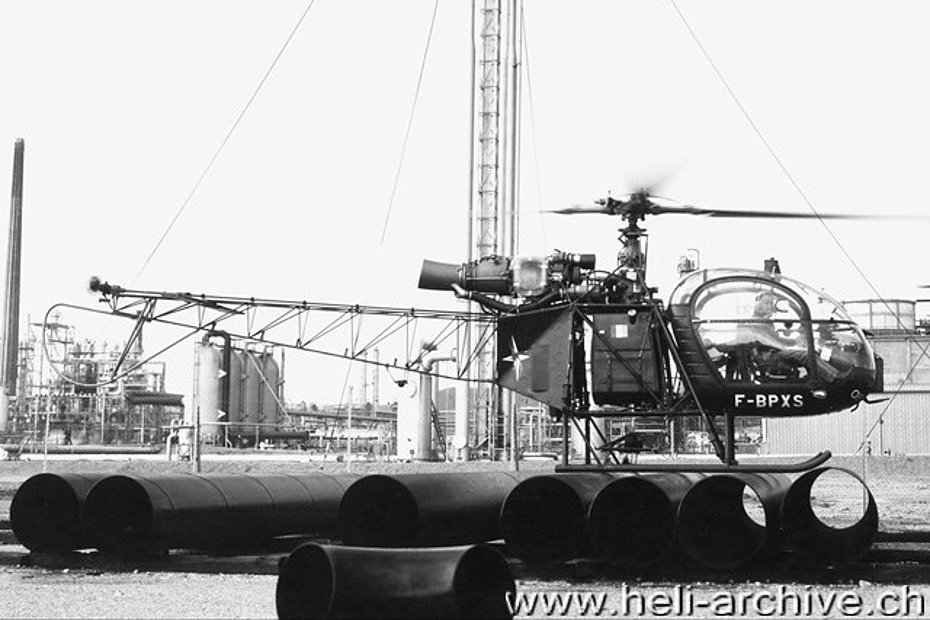
With one of these helicopter, built in two units (F-ZWVM and F-ZWVN – later re- registered F-ZWVB) the famous French test pilot Jean Boulet on 9 June 1958 set a new world record climbing to an altitude of 10'984 m.
However, for various reasons, this version never went into production, but inspired the construction of the SA 315B Lama.
Towards the end of 1968, the Indian Air Force was looking for a helicopter suitable to be used at high altitudes in the Himalaya region. According to the military specifications the helicopter had to be able to carry, along with a two-man crew, a payload of at least 200 kg and land and take off at an altitude of 6'000 meters. Even the SE 3160 Alouette 3 wasn't able to meet the needs of the Indian military authorities.
The helicopter division of Aérospatiale brushed up the plans of the SE 3150 and quickly readied the prototype SA 315A c/n 001 which received the registration F-BPXS and was outwardly very similar to the SA 318C Alouette 2. As said the "new" helicopter was assembled using parts of the Alouette 2 and 3 series.
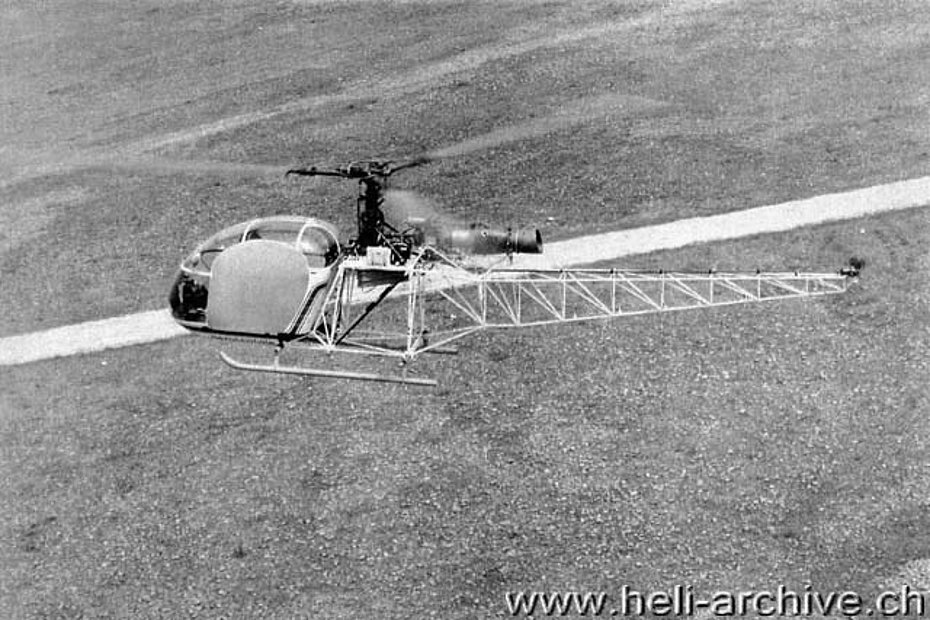
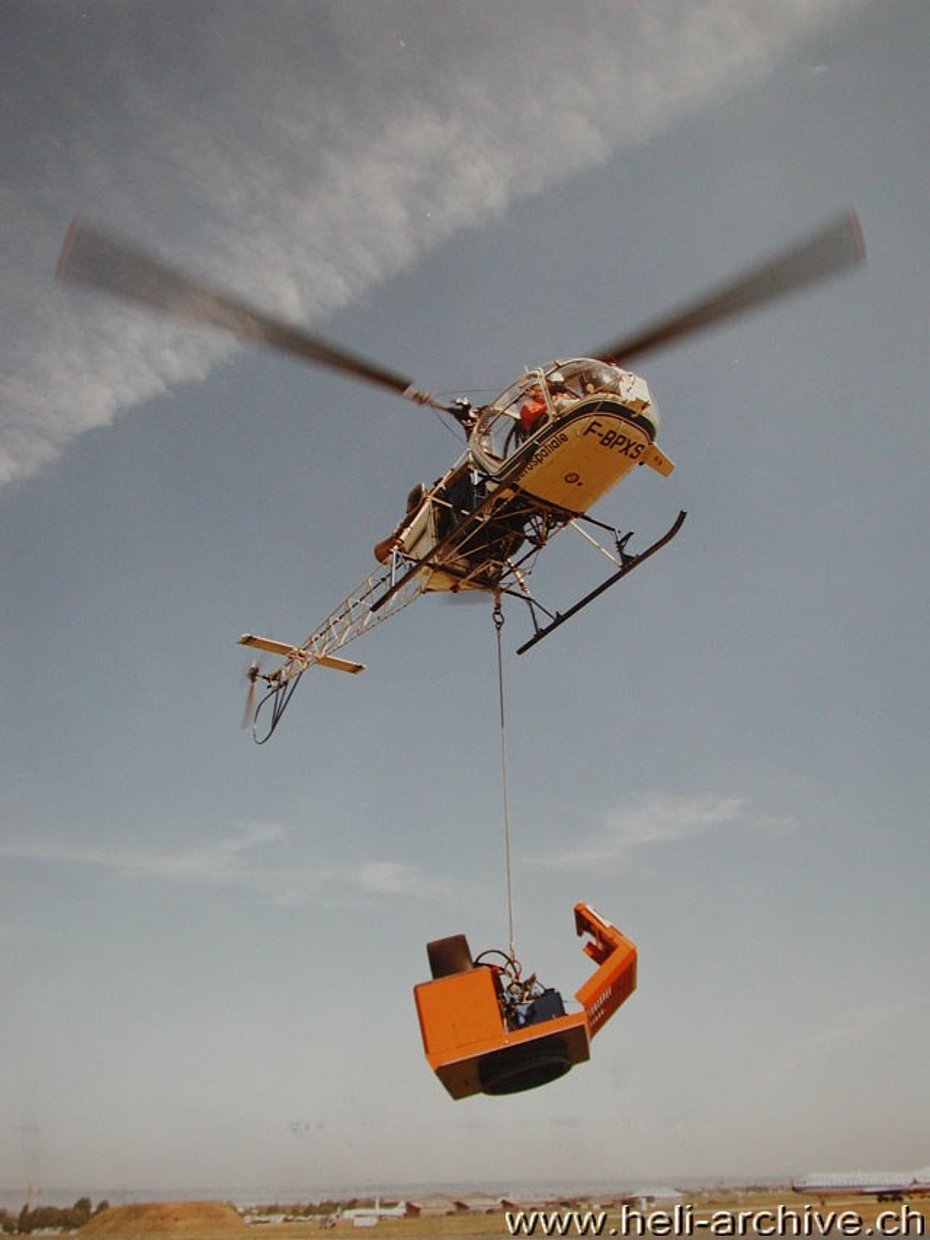
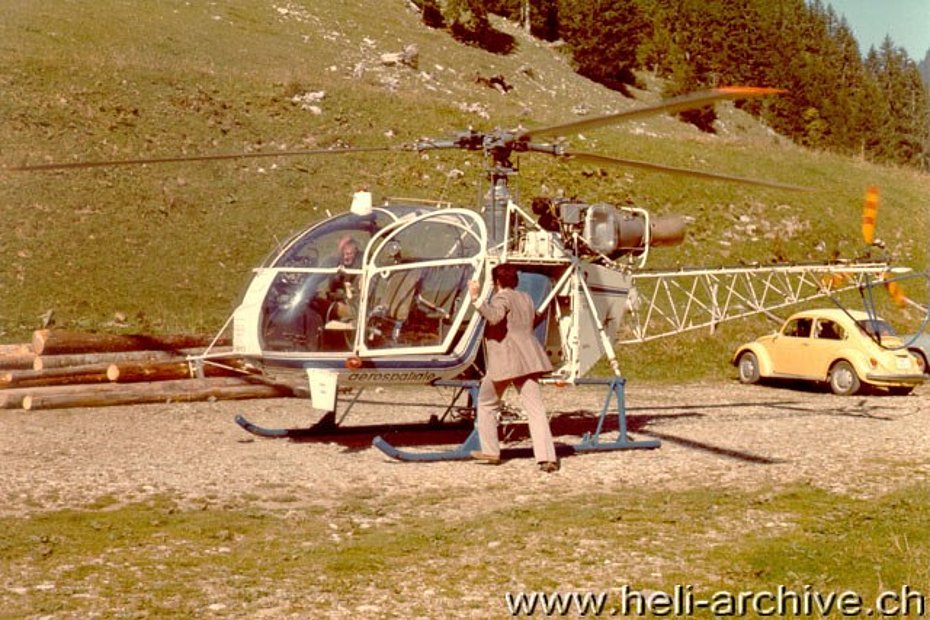
The Indian Air Force was fully satisfied with the new helicopter. During the demonstration trials held in 1969 in the region of Karakorum, a mountain range sitated in the north-west of the Himalaya, the prototype performed take-off and landings at 6'858 meters.
As it has become a tradition, the manufacturer chose the name of an animal to match with the new helicopter, and since 1970 this helicopter is officially known as Lama.
The name was almost certainly inspired by the original South American camelid often used as pack animal in the high mountains. Different south American countries also employed the helicopter, especially for search and rescue and supply flights. Among these last there were Argentina, Chile, Bolivia, Ecuador, El Salvador and Peru.
The altitude record
The flights in the Himalaya region were only the prelude of a long and brilliant career. In order to promote the sales of the new aircraft in 1972 Aérospatiale modified and lightened the F-BPXS as much as possible in order to establish a new world altitude record. Consequently the emptly weight was reduced from about 1'100 kg to 790 kg.
Someone of the Aérospatiale team suggested to land the helicopter on the top of the Everest, however Henri Ziegler, who was the group president and general manager, opposed the idea to land on the "Roof of the World" which he considered, as sport climber, "sacred".
On 21 June 1972 in Istres/France Jean Boulet, who already held an altitude record, climbed to 12'442 metres (40'833 feet), a record that has been unofficially beaten on 25 March 2002 by the French pilot Fréderic North who climbed to 12'954 m (42'514 feet) with an AS 350B2 Ecureuil.
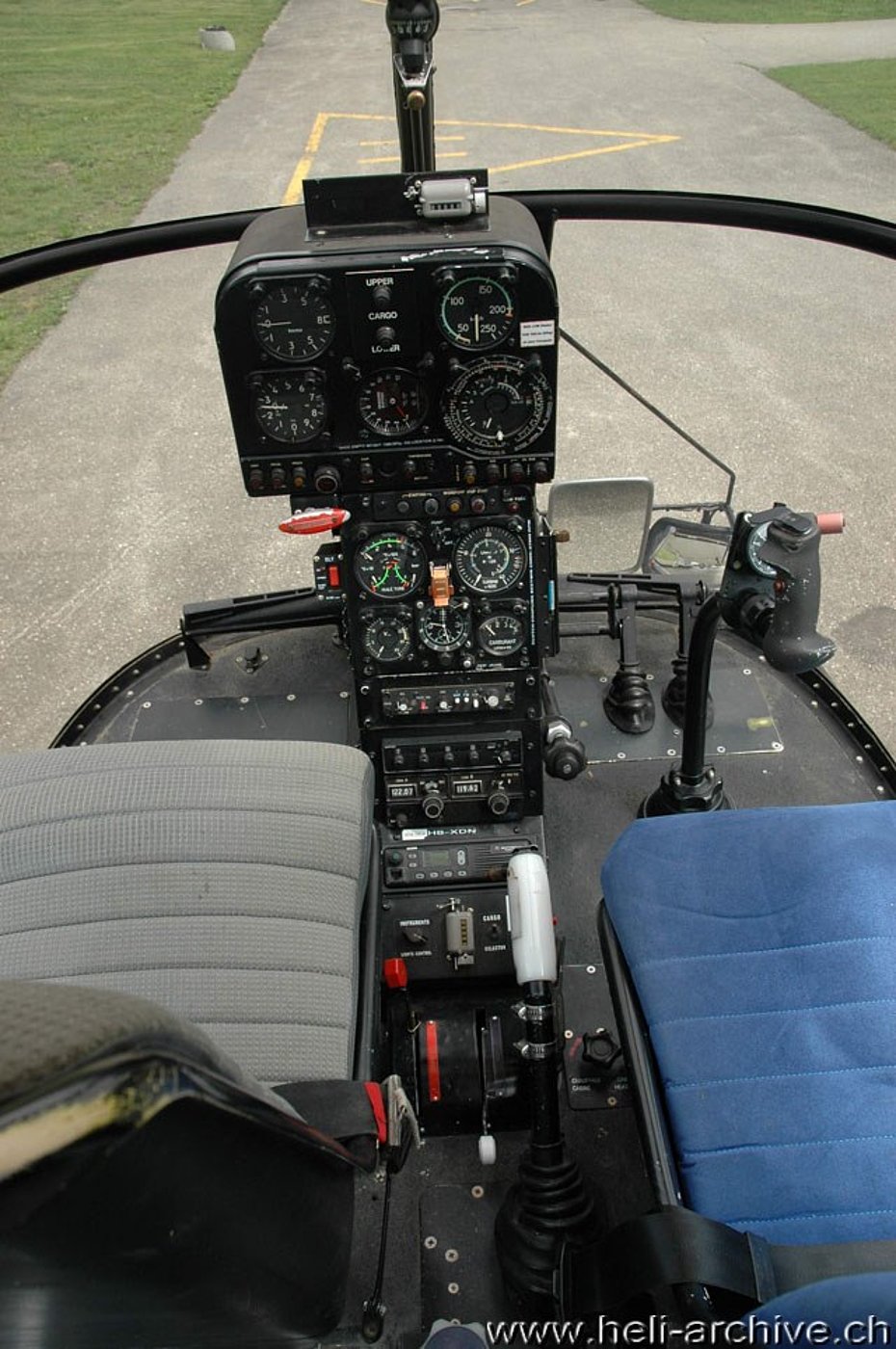
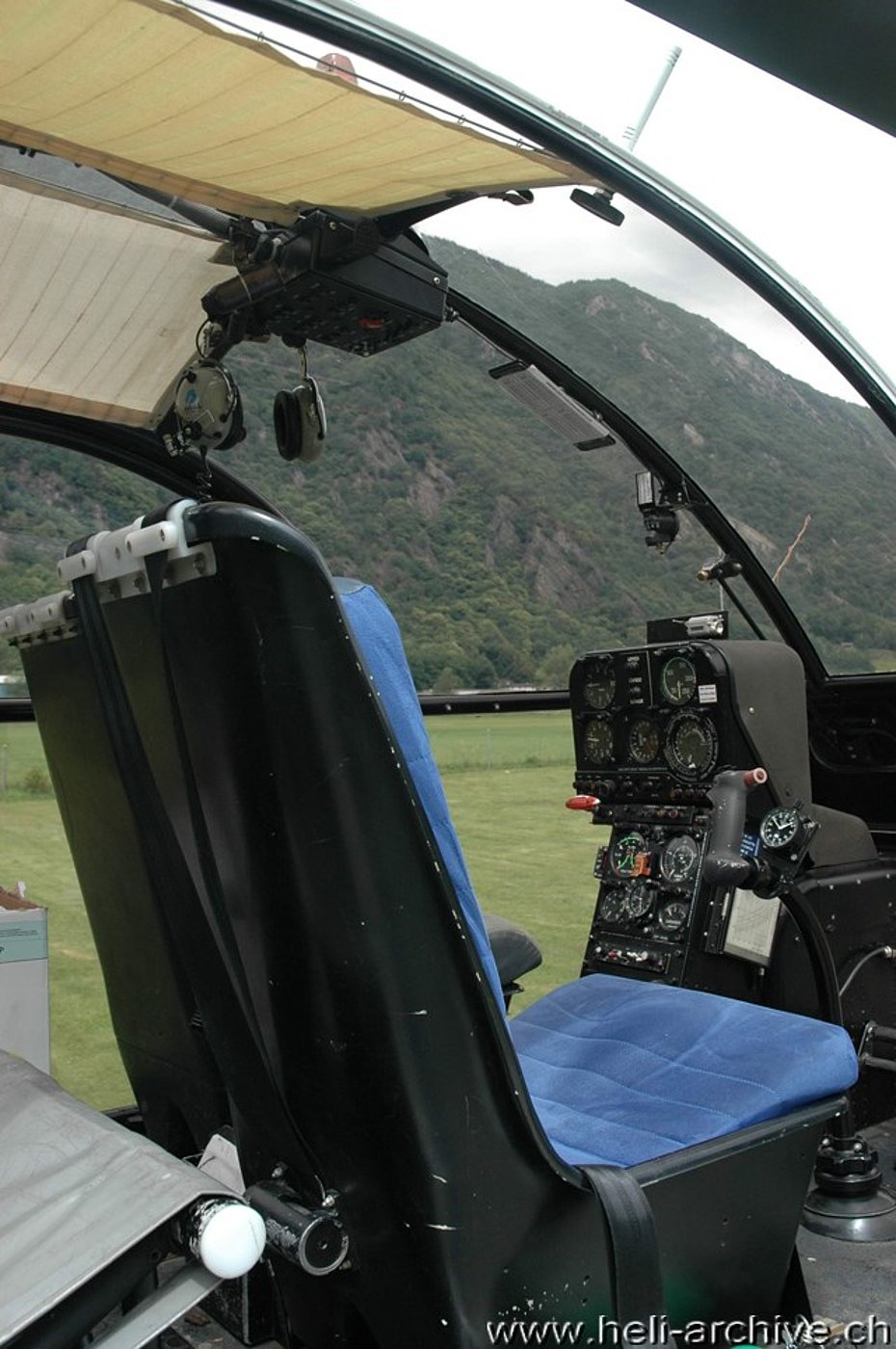
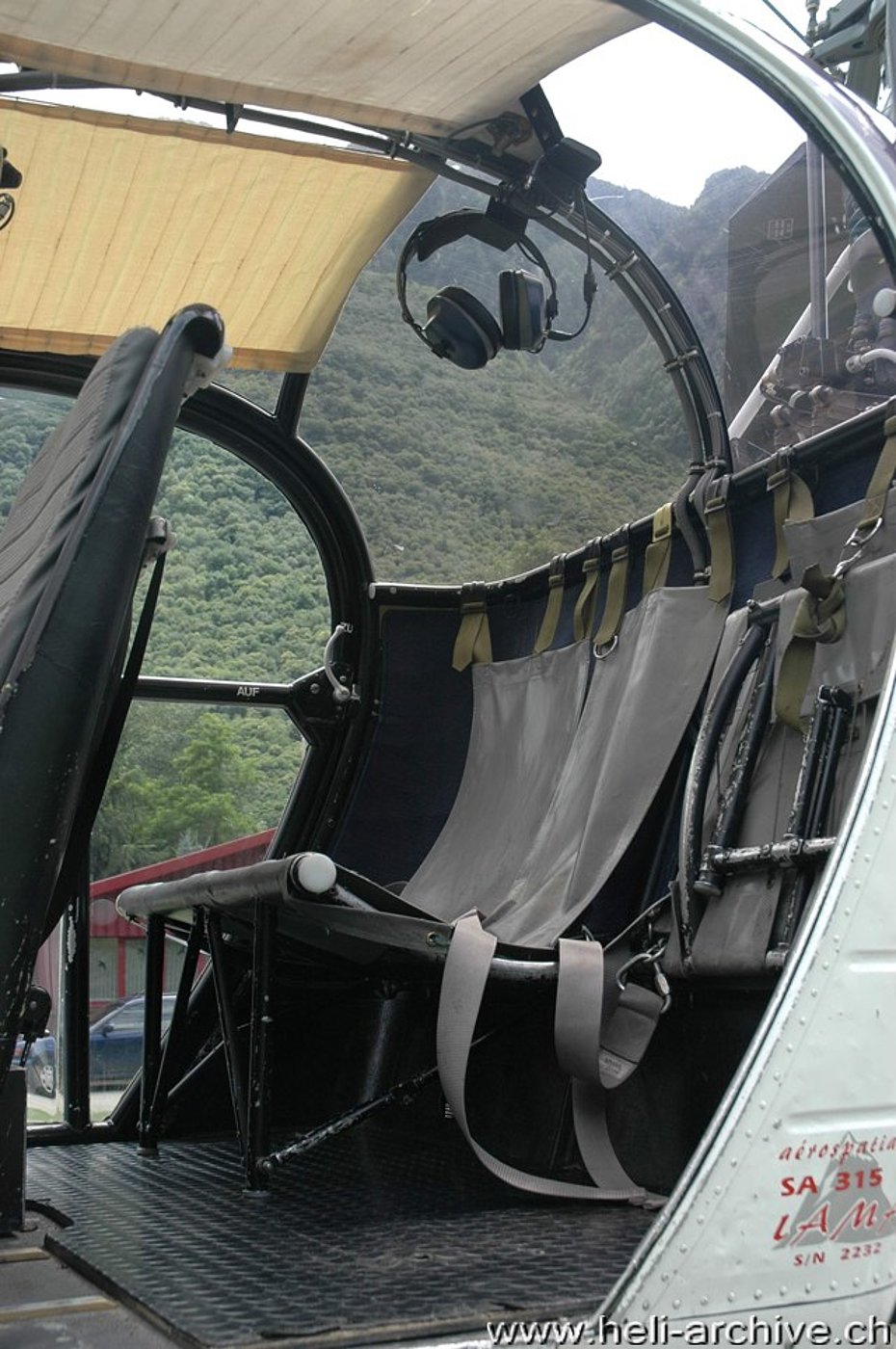
Boulet at the same time involuntarily established another record, that of the longest autorotation. The turbine in fact went out when he reduced the power: the outside temperature had in fact fallen to -63°C!
The French civil aviation authorities issued the airworthiness certificate on 30 September 1970. At the same time the helicopter went into series production and the first left the assembly line early in 1971.
In addition to the military customers earlier mentioned the SA 315B Lama has also been used by the army of Pakistan, Angola, Morocco and Togo and obviously numerous civilian operators around the world, especially in the mountain regions of Europe, Canada and the United States.
In Europe, but especially in France, Switzerland, Italy and Austria, this aircraft has been widely used for air transportation. It still continues to operate to the satisfaction of the various operators. The end of its career, however, as mentioned is coming to an end.
A preannounced end of career
During a seminar held in Marignane in December 2010 Eurocopter (which is the actual holder of the type certificate) explained the reasons that led it to take the decision to revoke the type certificate of the Lama (and Alouette 2 and 3 series). According to the French manufacturer this will come at the end of 2020 and will mean a stop to the commercial operations after more than 60 years since the first flight.
The reasons of this decision are varied in nature and only a few are mentioned hereafter: as regards the construction of the main and tail rotor blades for example, the old process of construction and related materials are no longer possible also for environmental reasons (use of materials such as chrome and cadmium).
Several materials and metal alloys used in the past are also no more available and the search for alternatives and the subsequent construction and certification would cause disproportionate costs in relation to a small production in series. For some old machinery used to manufacture special pieces the after-sales service is since long expired.
There are also many other reasons: one of these is the desire to reduce noise and environmental pollution (the new turboshaft consumes 30-35% less and are much less noisy) and direct maintenance costs.
However one problem mentioned without much importance, but perhaps decisive, is the fact that as a result of changes that have occurred since the days when the family of light helicopters turbine was manufactured by Sud Aviation, the French manufacturer has "lost track" of many light helicopters due to the continuous changes of ownership. To understand the problem, you should know that the initial type certificate holder of an aircraft, even in the event of proven defects in accidents attributable to the age of the aircraft is nevertheless liable. Also the components taken down from a helicopter out of service, in the absence of a control, may reappear on a helicopter currently used somewhere in the world without being able to verify the actual state, creating a high risk to the flight safety, as well as for the certificate holder.
The Lama, an icon in the field of the aerial transportation, thanks to its extraordinary qualities has been for many years a challenge for the manufacturers who were looking for a suitable replacement. However Eurocopter has found a valid successor, namely the AS 350B3 Ecureuil, universally regarded as the direct heir of the Lama. Even the most loyal pilots do not hide that the B3 is really a viable alternative, very powerful and a worthy successor to the Lama.
Last but not least as we all know the manufacturer offers a range of modern machines capable of performing the tasks previously assigned to the Alouette 2, Alouette 3 and Lama, and it is obvious that it seeks to promote the sale of these machines!
However mountain helicopter pilots often affirm that the latter is more stable and thus easier to fly especially in windy conditions.
The SA 315B Lama has been produced under license in India by Hindustan Aeronautics Ltd. HAL Bangalore under the name "Cheetah" while in Brazil it has been assembled by Helibras where it is known with the name Gaviâo (hawk).
At the end of 1972 the units manufactured were 78, ordered by 19 operators located in 11 countries.
Overall, according to the data provided by Eurocopter, between 1969 and 1985 447 aircraft were produced. Around fifty those converted from Alouette 2. Then there are those manufactured in India whose program initially included 140 aircraft, 40 of whom were at the beginning completed with parts manufactured in France. The first model assembled in India flew the 6 October 1973.
In 1981, 10 years after the start of the series production, Aérospatiale had manufactured 285 units, while 133 were those produced in India by HAL.
In 1971 the selling price of a Lama with standard equipment amounted to about 745'000 Swiss Francs, or about 2'000'000, indexed today (2013).
General description and characteristics
The SA 315B Lama is a light multi-role five-seater turbine powered helicopter of standard configuration.
The helicopter is basically made of three main parts: the cabin, the center frame and the tail boom.
The cabin (dimensions 130 x 196 x 133 cm height) consists of canopy and floor. The canopy has a metal frame which supports the Plexiglas panels. Two large metalframed Plexiglas doors offer unrestricted view in all directions for the pilot and the four passengers.
The two frontal seat (the one on the right is that of the pilot) are adjustable fore and aft and have a small compartment for documents and maps.
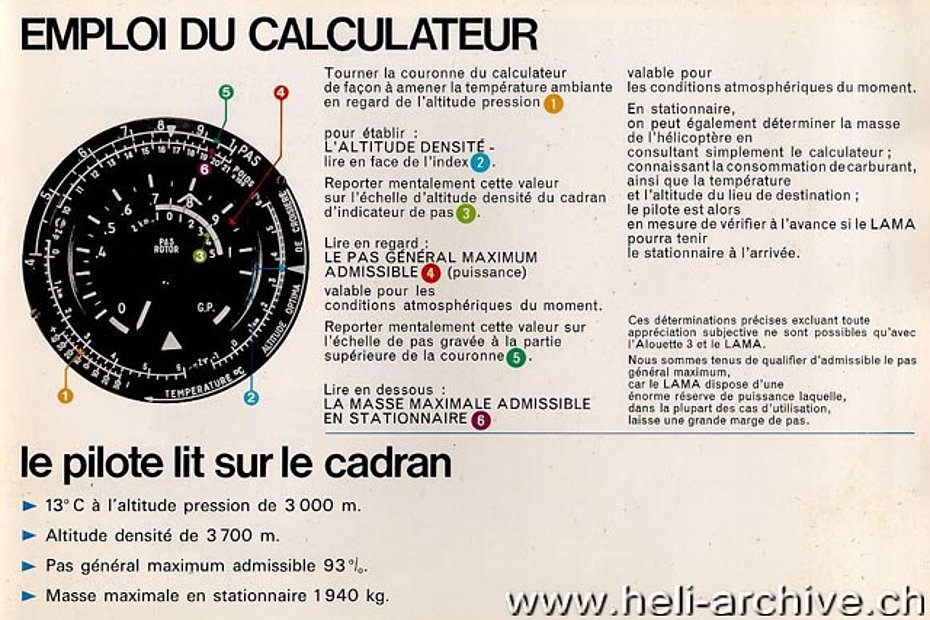
The console which supports the instruments panel is located right on the aircraft center line. The floor is a rigid box-type construction. Cargo tie-down fittings are easily added.
A cargo space of 1.70 cubic metres provides for a maximum internal load behind the two front seat of 230 kg. If necessary the rear bench for the three passengers can be folded.
For the occupants comfort there are over heads sunshades, a front vent and an air vent located on the doors.
A removal panel on the underside of the cabin gives quick access to flight and engine controls, electrical and radio circuits. The radio compartment inspection panel is placed in front of the cabin.
The electric power is provided by a 28.5 V 4 kW generator. The 40 Ah nickel cadmium battery is located in the front of the cabin under the electric panel in a well ventilated space.
The "trip computer"
Like in the Alouette 3 the pilot can use a "computer" (nothing to do with computers that we know today!) that allows to calculate the maximum permissible mass hovering. Inserting the temperature at a given pressure altitude, we obtain the density altitude, and hence the figure for the maximum pitch (pas general) valid for the atmospheric conditions of the moment. Then with this value is obtained the maximum permissible mass hovering. With a little practice the calculation can be determined in a precise way.
On the practical side, however, the computer is not much used especially by civilian pilots who rely rather on their experience.
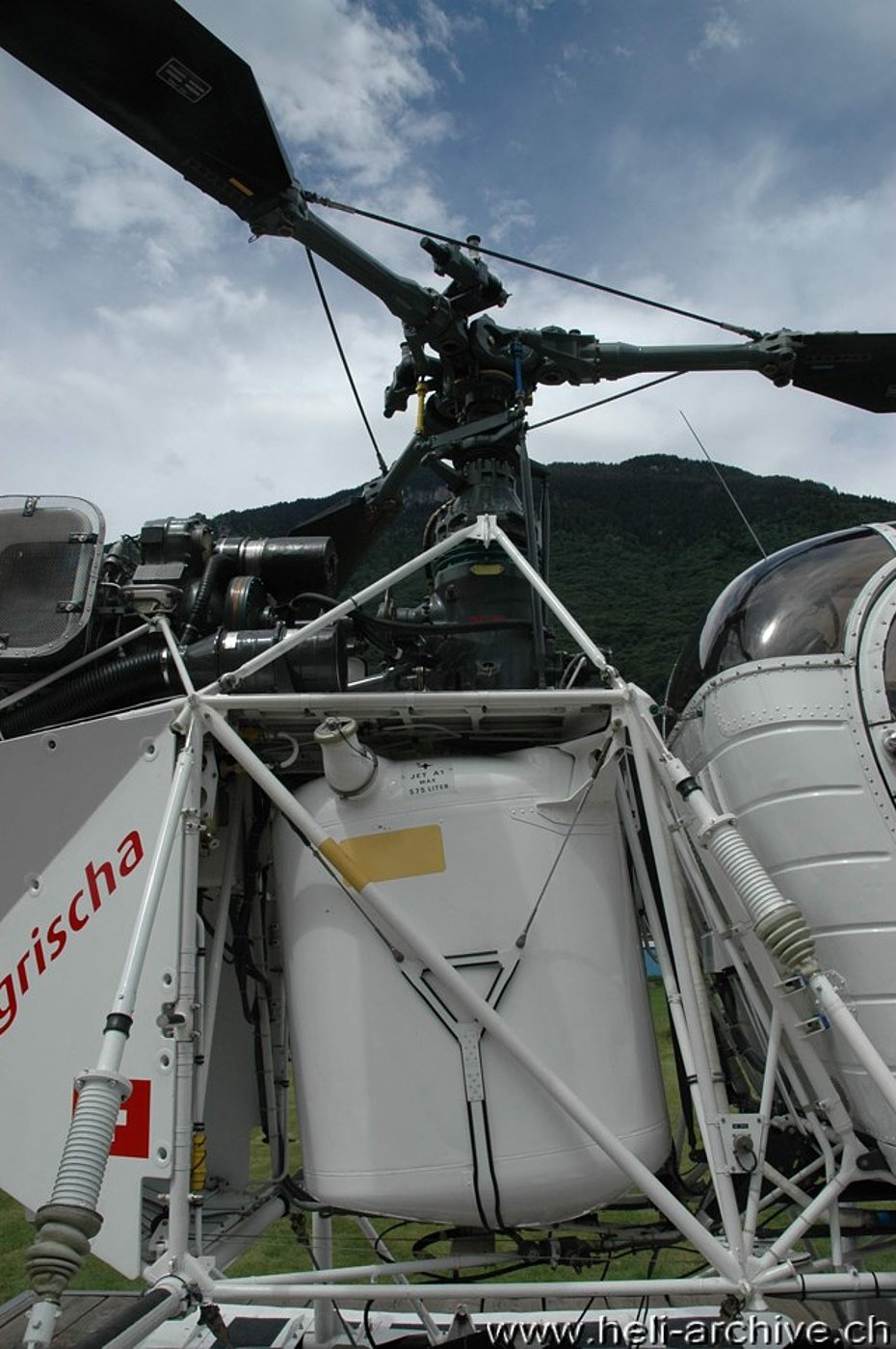
The center structure
The center structure is made of welded steel tubes covered with two detachable fairings, and a transmission support platform commonly called plancher mécanique which carries other components. The structure encloses a 575 litres capacity fuel tank (Jet A-1 kerosene is used) isolated from the power unit by mean of firewalls. Some aircraft are still fitted with the old 580 litres squared fuel tank, the same of the Alouette 2.
The landing gear (higher if compared to the SE 3130/313B/3180 Alouette 2) is made of two flexing cross tubes with hydraulic shock struts designed to absorb landing impact. The two duraluminium tube skids (reinforced with thin steel sheet) curved upward are interconnected by two steel cross tubes attached to the center section. Skids carry each a retractable wheel for ground handling.
The turboshaft is horizontally mounted and is attached to the body structure at three points.
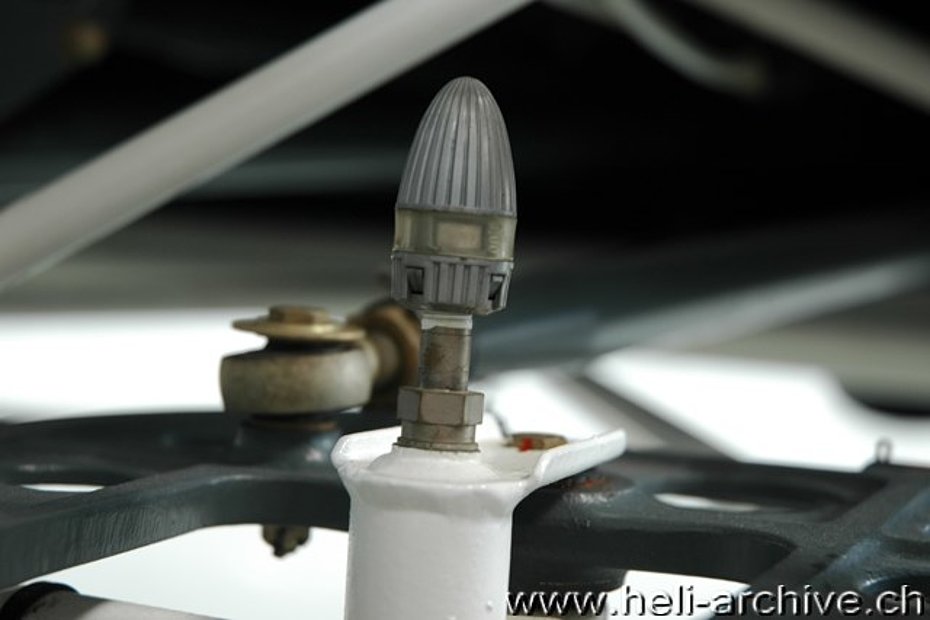
The tail boom
The tail boom is attached to the aft end of center section and supports the fixed stabilizer, the tail rotor gearbox, the tail rotor and its protection arc.
The main frame and the tail boom are made by welded steel tubes. Nitrogen is fitted into the tubes. If a leak occurs due to a crack in any of the tubes, air will come inside the tubes and the video-pi indicator will change its colour telling the pilot or the engineer that there is a problem with the main frame or the tail boom. It is a unique and very bright safety device.
Rotor, transmission and controls
The SA 315B Lama has a three blades fully articulated main rotor and a three blades tail rotor.
In flight the main rotor rotates at 353 rpm (2'001 rpm tail rotor). During the autorotation variations between 280 and 420 rpm are admitted. The main rotor transmission transmits power to the main and tail rotor and consists basically of an input bevel gearing and two planetary reduction stages.
The main drive shaft freewheel unit connects turbine to main gearbox and permits autorotation in case of emergency. The helicopter has conventional controls and is equipped with a single hydraulic system, which provides hydraulic boost to the cyclic and collective.
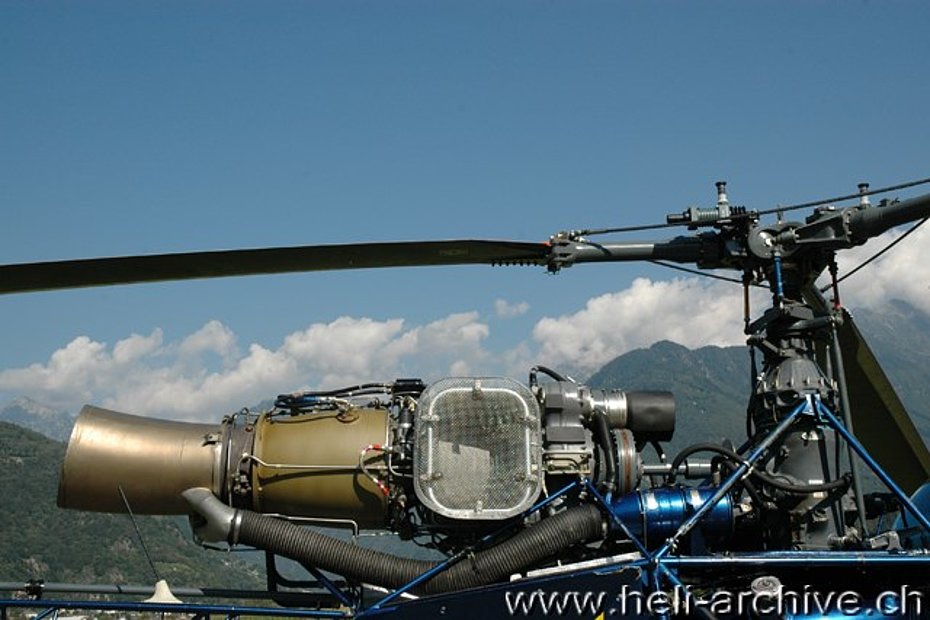
The turboshaft Artouste IIIB1
The SA 315B Lama is powered by an Artouste IIIB1 manufactured by Turbomeca, a French company founded in 1938 by Joseph Szydlowski. This turboshaft has been certified by the French Official Services on 25 May 1961.
The Artouste IIIB1 is a single-spool turboshaft engine with a constant rotational speed, derived from the Artouste IIC which powered the SE 3130 Alouette II. It differs from the latter mainly because it has an additional compressor stage and turbine which gives it better performance and greater power.
This engine develops in fact a max take-off thermal power of 640/870 kW/hp, even if this power is deliberately reduced to 440/590 kW/hp for take-off and 405/550 kW/hp continuous.
With respect for the limits imposed by the manufacturer, the transmission absorbs a continuous power of 398/542 kW/hp.
The first Lamas were powered by the Artouste IIIB variant which is the basic version derived from the Artouste III. The two versions are almost identical, even if the Artouste IIIB1 incorporates some minor changes that allow an increase of the maximum powershaft from 420 to 440 kW.
Very probably the adoption of the Artouste IIIB1 version has also allowed an increase of maximum takeoff weight with load in the cabin, risen from an initial 1’750 kg to 1’950 kg, respectively, with the maximum external load increased from 2’200 kg to 2’300 kg.
The turboshaft is equipped with a speed governor which maintains a constant speed of 33’500 rpm during the flight.
The Artouste IIIB1, with its characteristic prolonged roaring sound, includes: a single-stage axial compressor, a single-stage centrifugal compressor, a direct flow annular combustion chamber with centrifugal fuel injection, a three-stage axial turbine, an exhaust diffuser, the main power offtake, the drive gears of the various accessories (fuel pump, speed governor, oil pump, starter generator, tachometer, generator).
The axial compressor and the three-stage axial turbine are mounted on the same axis. This grants an immediate response to each input from the pilot.
The maximum permissible temperatures (temperature outlet turbine or TOT) are the following: take-off (5 min) 550°C, continuous 500°C. The turbine exhaust gas temperature is measured by two thermocouples.
The turboshaft weights 182 kg and is attached to the fuselage trough three points, allowing for easy replacement.
Overhaul interval of the turboshaft is 3'000 hours or 15 years (at the beginning the overhaul was requested each 1'750 hours of flight).
Start of the turboshaft
To facilitate the start of the turboshaft the manufacturer has provided an electromechanical system that allows a complex but reliable ignition by means of a single switch. The pilot, after entering the electric fuel pump for at least 30 seconds, places the same switch upwards on the DEM position (DEM = démarrage/start). He then must only monitor a sequence of lights on the instrument panel that show the individual phases of the start, as well as the eventual achievement of the maximun T4 (temperature outlet turbine) admitted (630°C).
In case of reaching or exceeding this limit, the pilot lowers the switch on the VENT (Ventilation = ventilation) position interrupting the flow of fuel. In doing so the starter-generator continues to function by lowering the temperature of the combustion chamber within the permissible limits.
Once started (normally this operation takes about 1 min) the pilot actuates the lever that regulates the flow of fuel and the engine speed increases slowly up to about 20’000 rpm from which the centrifugal clutch starts to run the rotor. The coupling between the engine and the rotor is monitored by the pilot on the engine/rotor instrument.
After a lapse of time that varies from a minimum of 30 seconds to 1 min, when the two gauges engine/rotor are superimposed, the coupling is completed and the pilot can push the engine lever fully forward and set it in the flight position. Reached normal operating temperatures and rotor rpm the helicopter is ready to take-off with the engine that runs at 33'500 rev/min.
Upon landing the pilot does the inverse operation bringing back the fuel lever to its rear stop. When the centrifugal clutch free again the rotor, and the latter turns below 175 rpm it can be stopped using the brake placed beside the gas lever. This allows the boarding of passengers with rotor stopped. If the pilot sets the main switch in the center position the engine is turned off. This shutdown phase doesn’t necessitate long intervals of turbine cooling, although it is recommended to avoid major problems relating to the lubrication circuit.
| Take-off mass | 1500 kg | 1950 kg | 2300 kg |
| Cruising speed | 160-170 km/h | 150-160 km/h | 120 km/h |
| Initial rate of climb | 480 m/min | 330 m/min | 235 m/min |
| Service ceiling | > 7000 m | 5400 m | 3000 m |
| Hoovering HIGE (ISA) | > 7000 m | 5050 m | 2950 m |
| Hoovering HIGE (ISA + 20°C) | 6750 m | 4400 m | 2300 m |
| Hoovering OGE (ISA) | 7000 m | 4600 m | 1550 m |
| Hoovering OGE (ISA + 20°C) | 6250 m | 3900 m | 800 m |
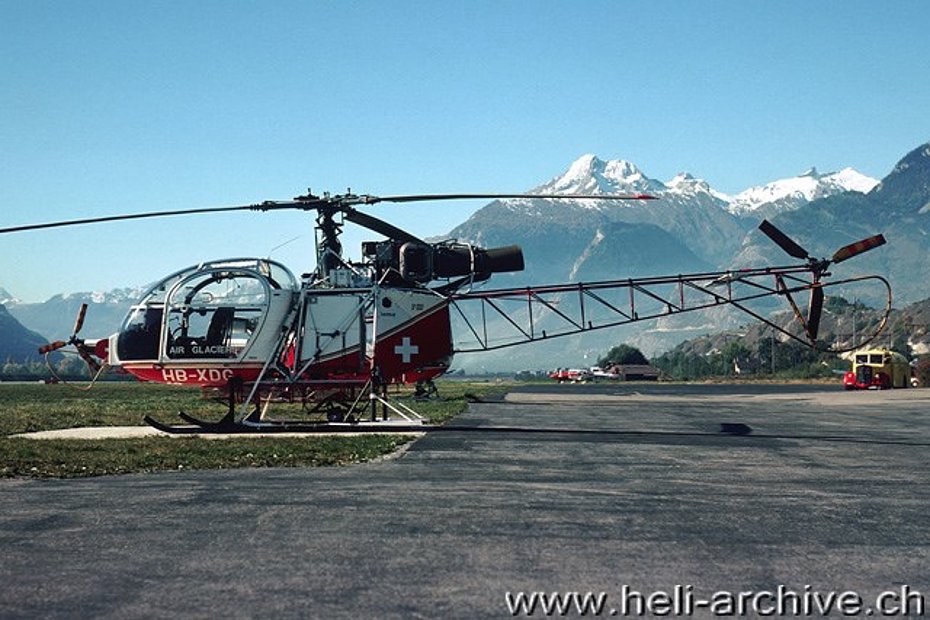
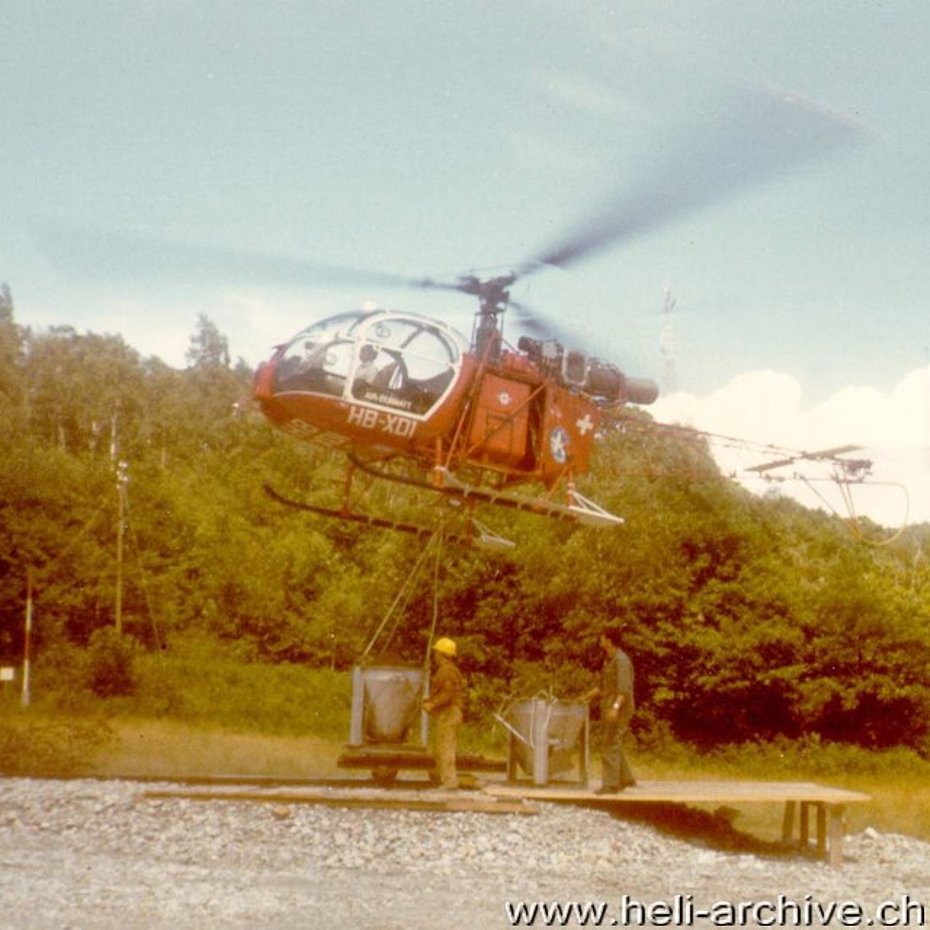
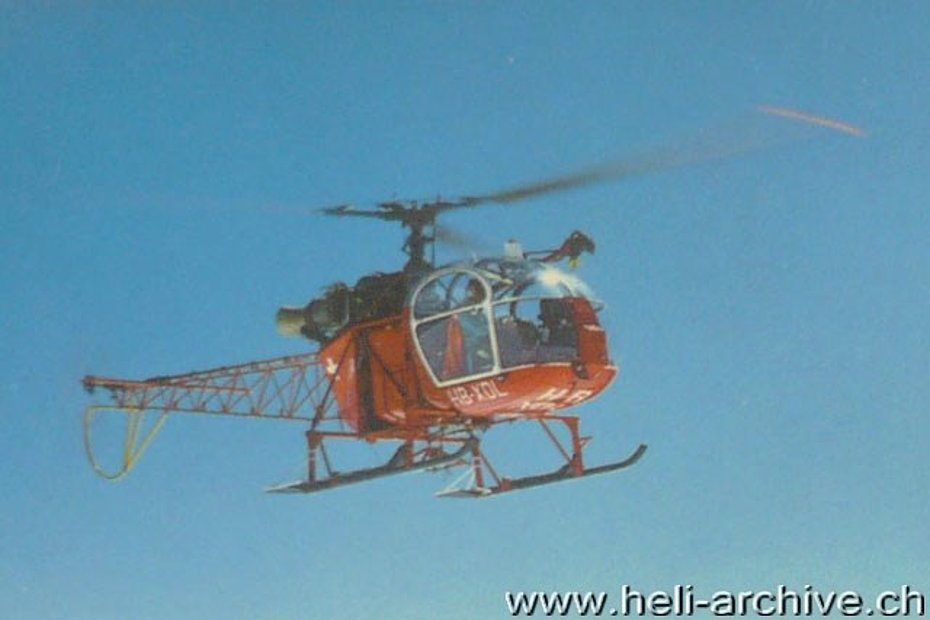
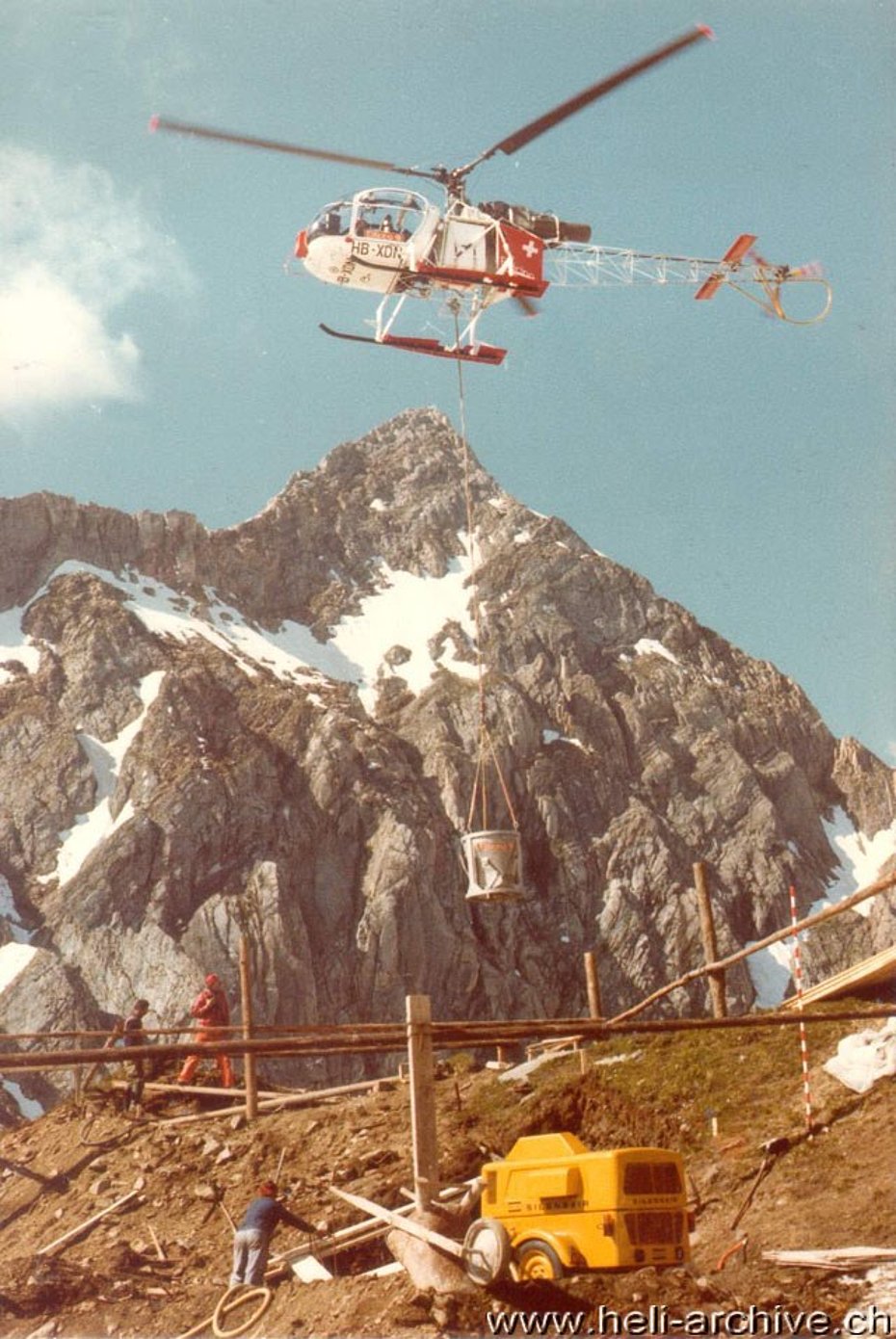
With an average hourly fuel consumption of 220 liters, its range is about 500 km, corresponding to 2h45min of flight endurance. The max permissible speed (Vne) is 210 km/h at sea level.
Dimensions, weights and payload
The main rotor of the SA 315B Lama has a diameter of 11.02 m (disc rotor area 95 m2), while its tail rotor has a diameter of 1.91 m (rotor disc area 2.87 m2. The fuselage has a length of 10.23 m. The height measured on the top of the rotor mast is 2.97 m.
The aircraft standard empty weight is about 1'100 kg, while its MTOW is 1'950 kg.
Allowing for a standard pilot weight (77 kg) and with a fuel and oil reserve for one hour of flight (about 184 kg) the helicopter can carry four passengers or, suspended on its barycentric hook, an external load up to 1'135 kg.
Rotor limitations
In flight the main rotor rotates at a constant speed of 353 rpm, while the tail rotor rotates at 2'001 rpm. In autorotation the main rotor rpm must be kept among 270 and 420 rpm.
Optional equipment
The versatility of the SA 315B Lama can be further enhanced with various additional equipments, as for example: dual controls, cabin heating, SAR installation, rescue winch, barycentric hook (SIREN or ERC on choice), front mirrors, skis for landing on snow, fixed or emergency floats, external baskets, VIP interiors, landing lights, anti-collision lights, static sand filters, agricultural spray kit, installation of oxygen, fire extinguisher, radio system.
Civil employ
The Aérospatiale SA 315B Lama has found a wide employ especially with the helicopter companies operating in mountainous regions.
Its multi-role character makes it suited for the transportation of passengers and merchandise, logging, firefighting operations, and also in the search and rescue role at high altitude.
Even if the number of those in service has constantly decreased in recent years this helicopter continues to be used mainly as aerial crane.
The SA 315B Lama in Switzerland
The Lama made its appearance in Switzerland in the spring of 1971. The first company to purchase one of this aircraft was Air Zermatt (HB-XDI s/n 2207 and HB-XDL s/n 2225), followed by Air Glaciers (HB-XDG s/n 2221) and Eliticino (HB-XDN s/n 2232). The success was immediate to the point that within a few years the mentioned companies (and others of course) purchased more aircraft. Within a few years the Lama became the icon of air transport by helicopter.
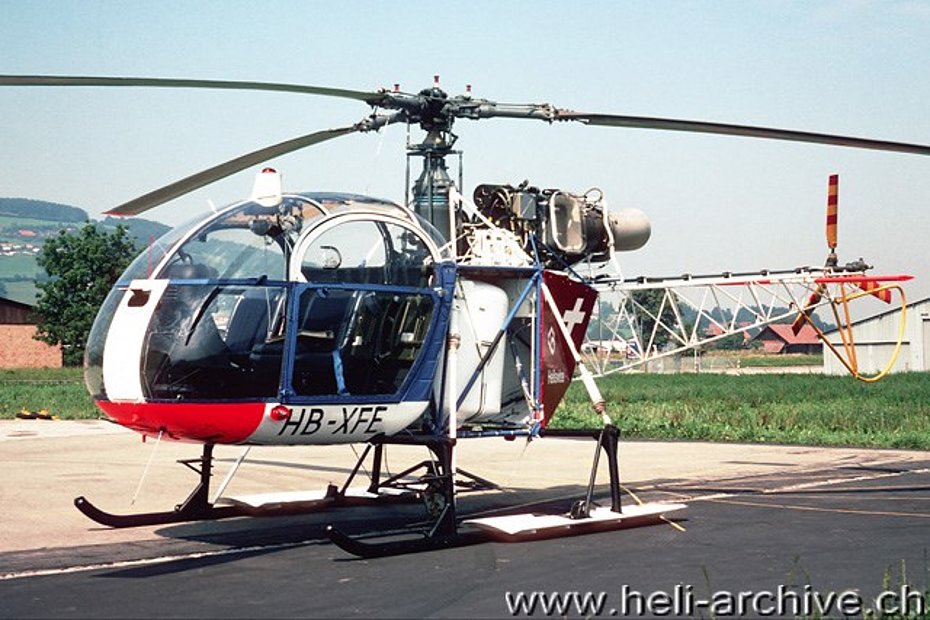
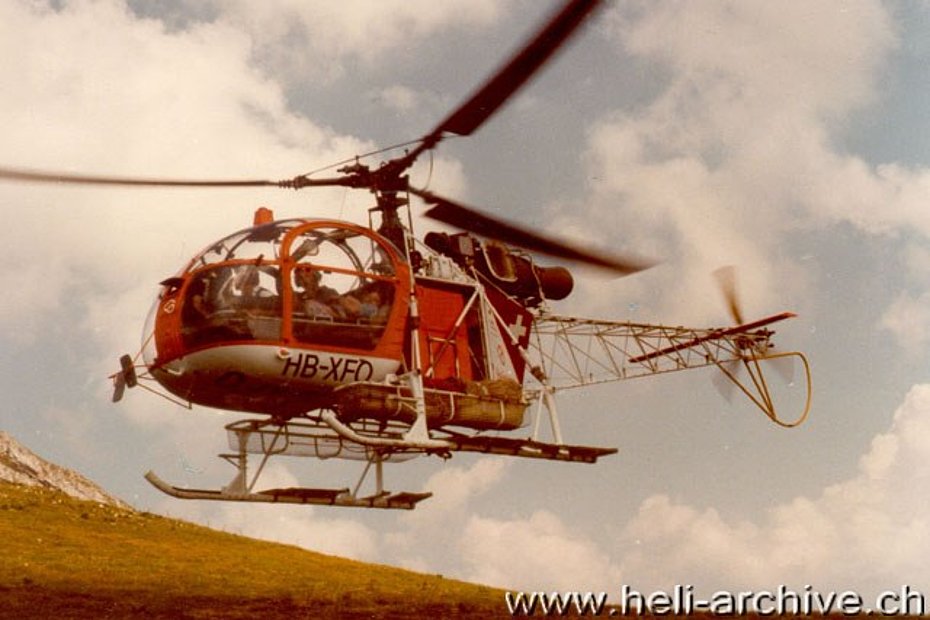
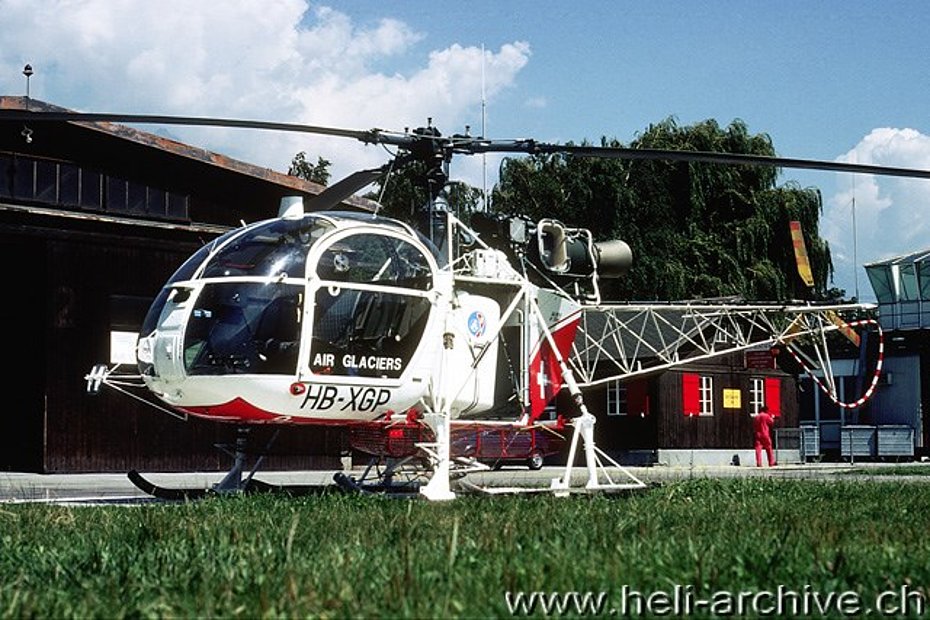
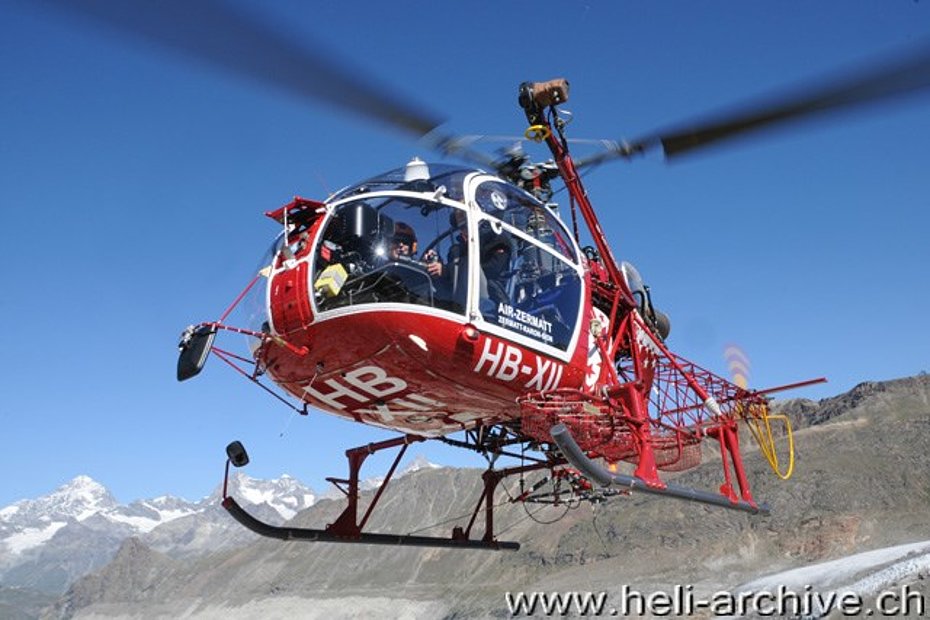
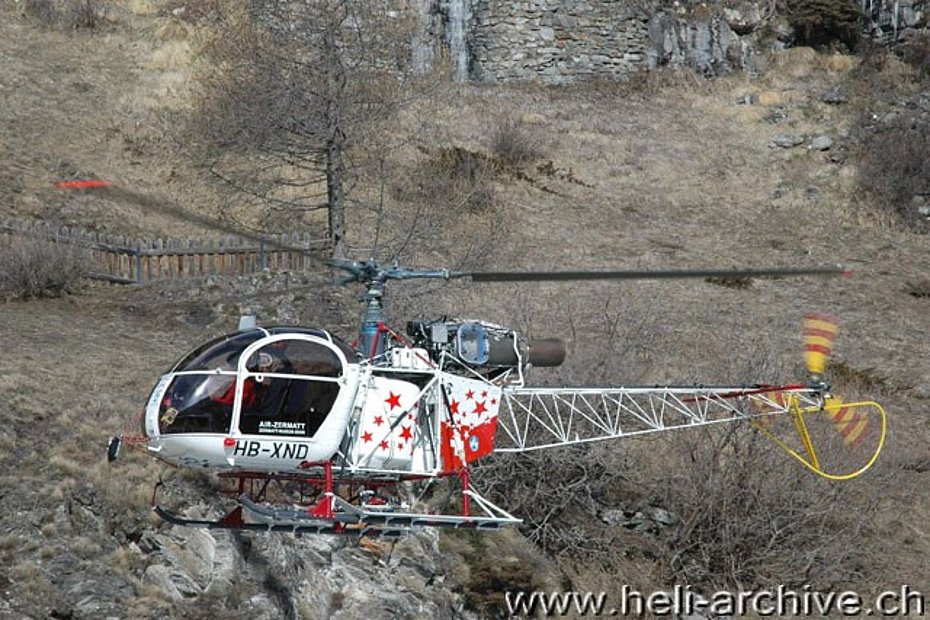
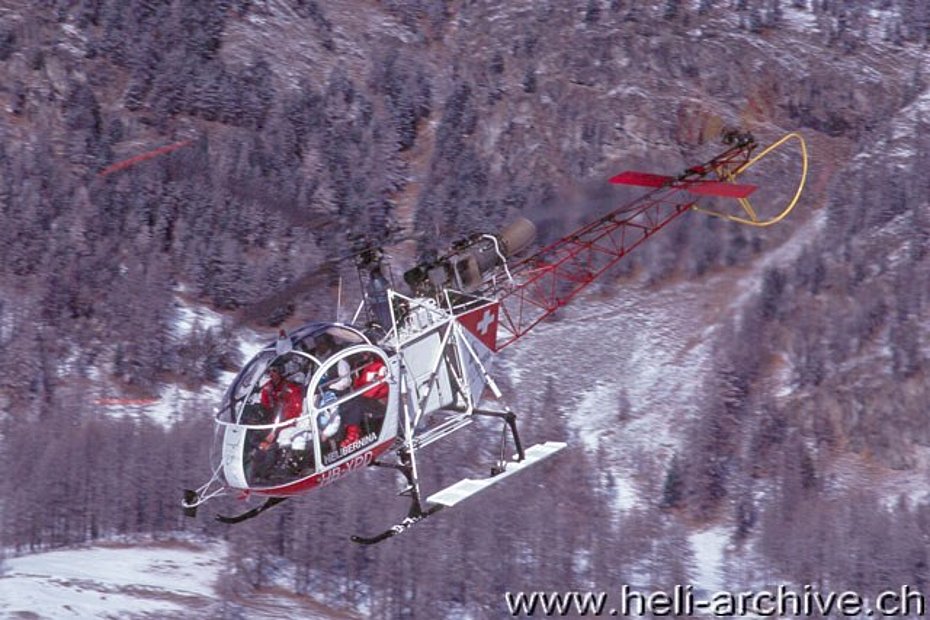
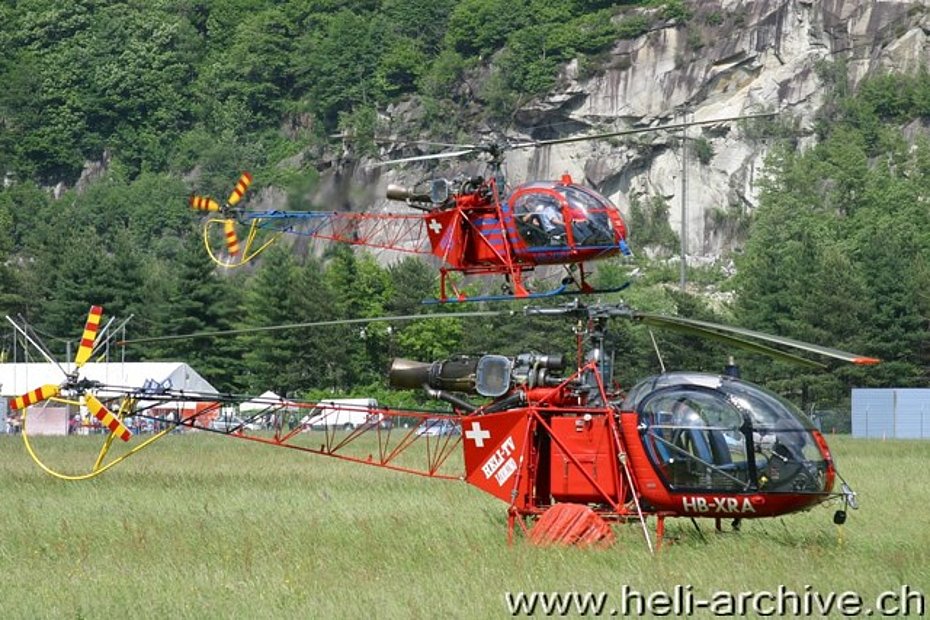
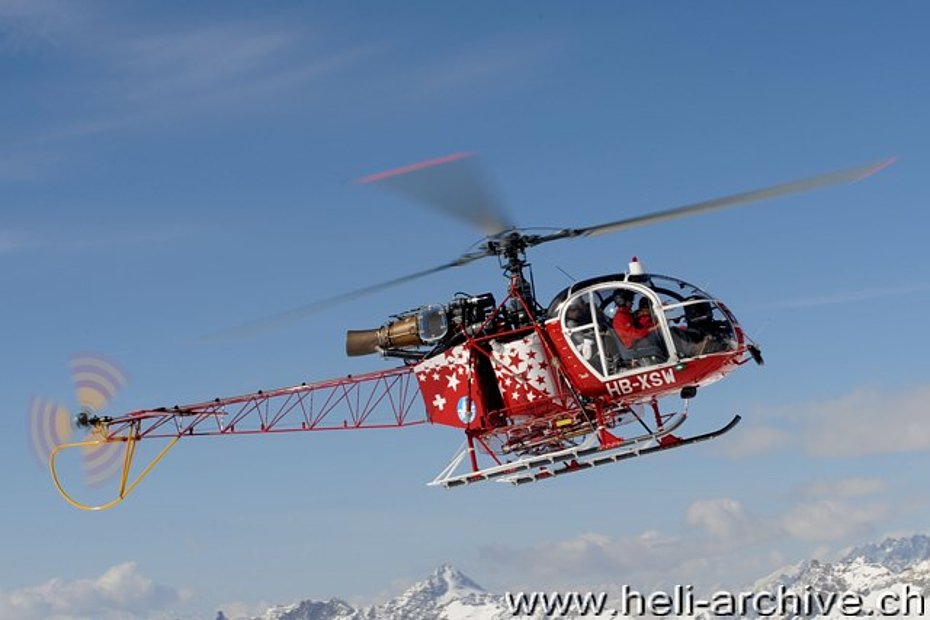
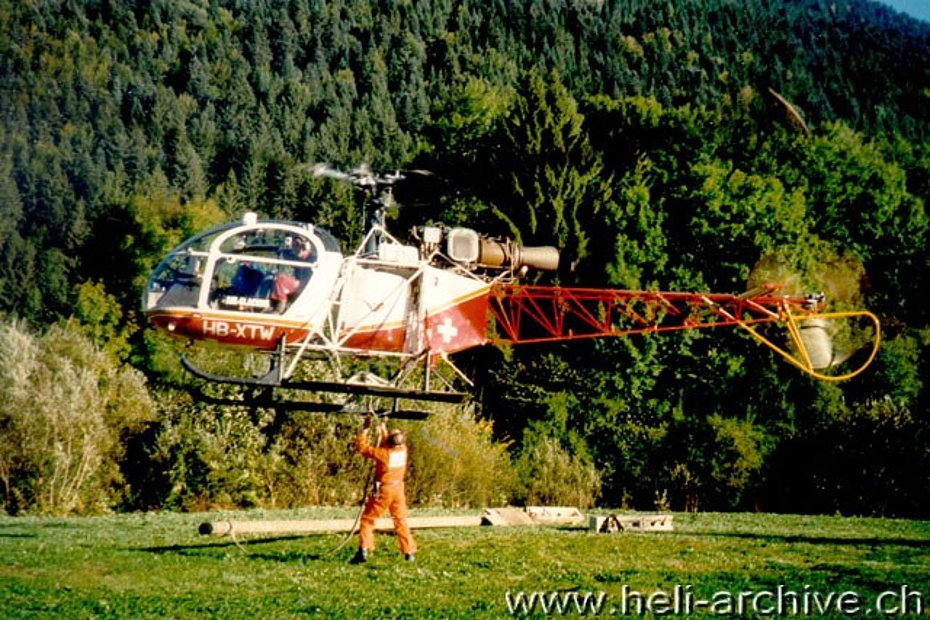
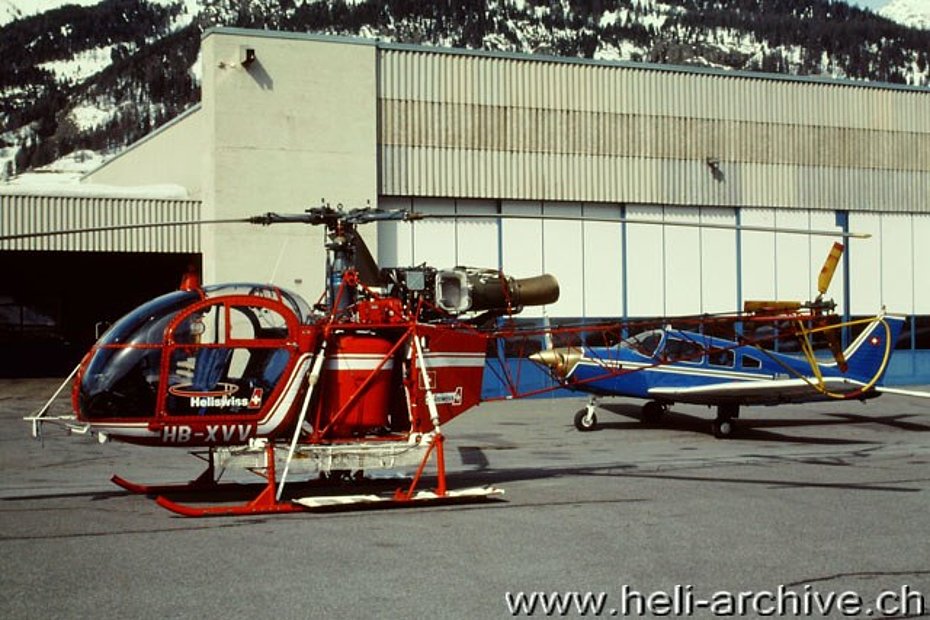
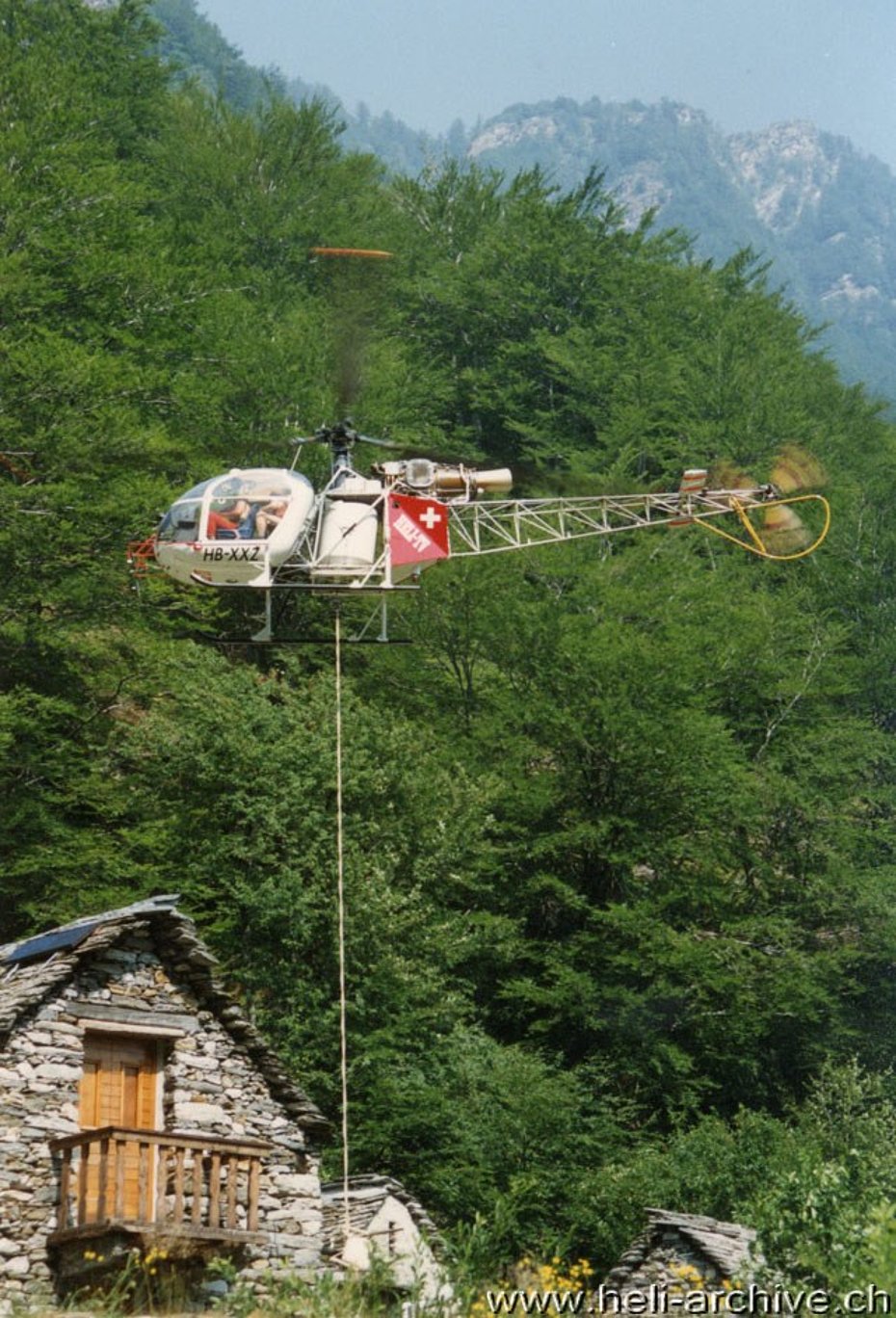
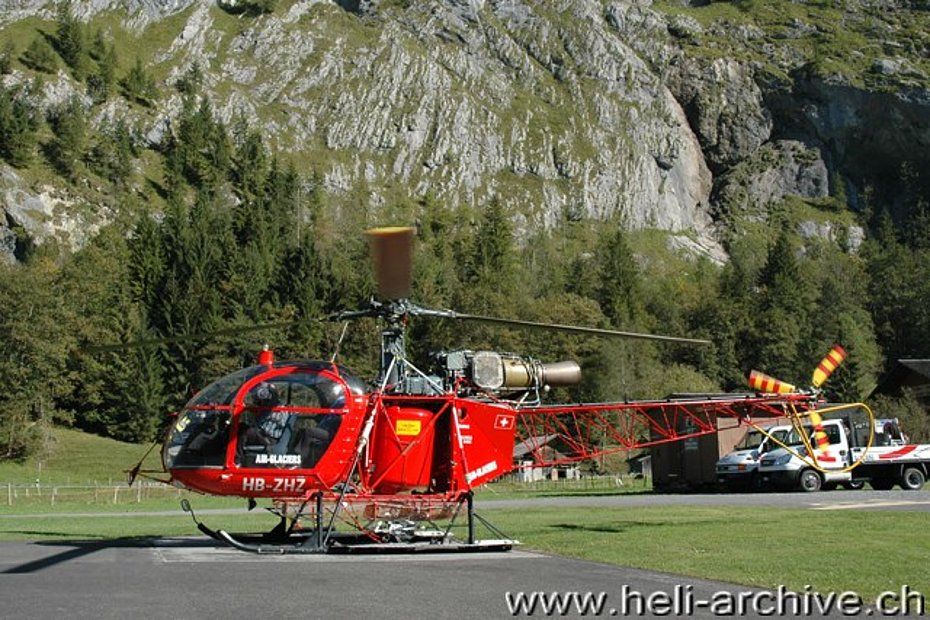
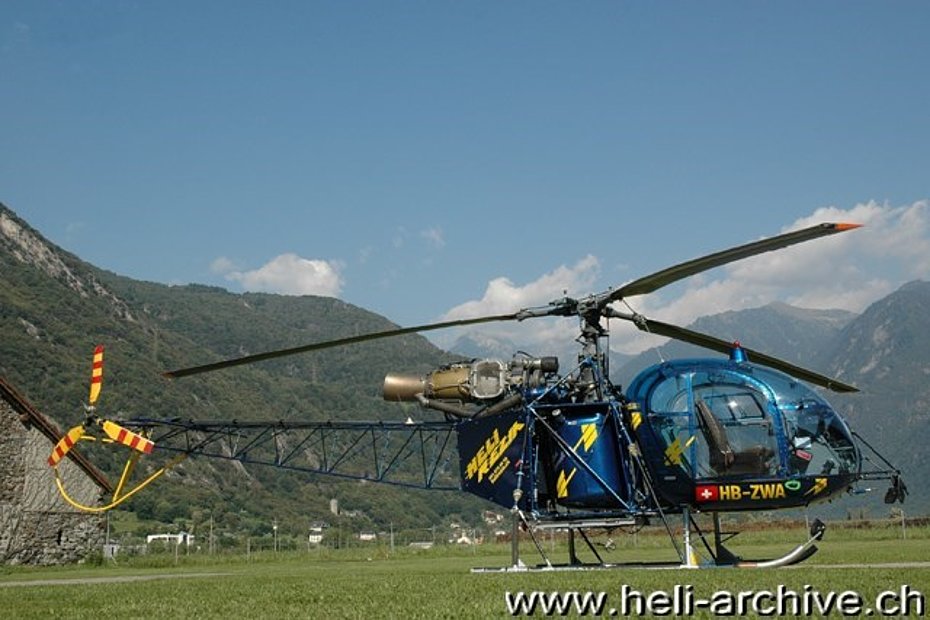
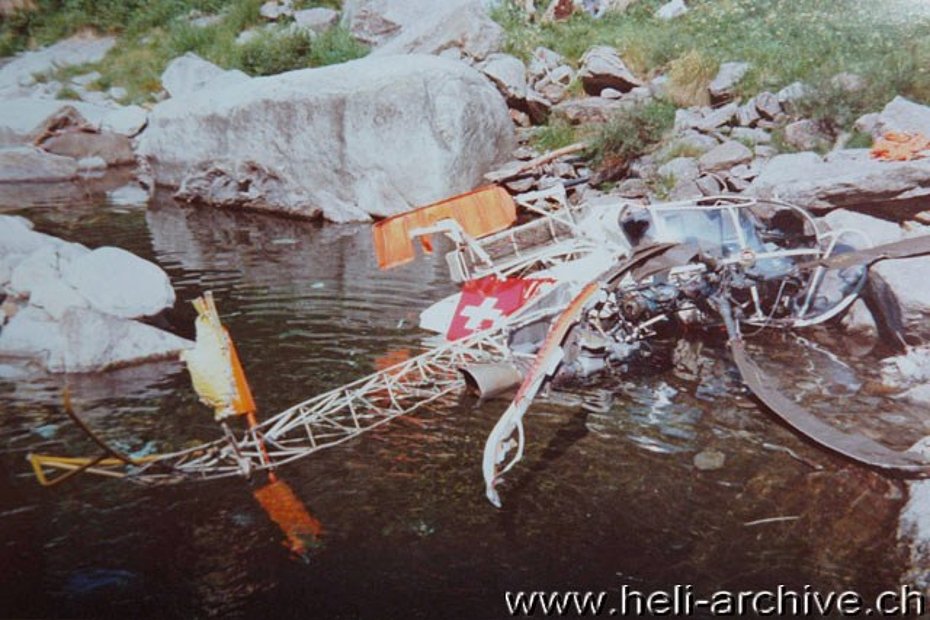
That were the years of the building boom during which new ski resorts, aqueducts, power lines, avalanche shelters, alpine huts, tourist resorts were built.
Everywhere, both north and south of the Alps, it was possible to hear the unmistakable sound (some would call it improperly noise!) of a Lama at work.
Until that time the transport of loads in excess of 350-400 kg were most of the times transported by the few Agusta-Bell 204B in service with Heliswiss or the SE 3160 Alouette 3 in service with Air Zermatt and Air Glaciers.
The introduction of the Lama coincided with the standardization of the external load transported of 800 kg.
In contrast to the first pilots who almost imposed their mechanics to prepare with attention the cargo, which should not generally exceed 750 kg (doing this they conserved the necessary margin of power reserve), over the years there has been a gradual increase in the average weight carried. You are likely to hear that this or that pilot transported loads of 1'100-1'200 kg.
Many pilots, however, went even further, especially during logging operations, abusing evidently of the large power reserve of this helicopter but perhaps aeven of healthy common sense!
"Of these overloads apparently no immediate trace remains," says a now-retired Heliswiss mechanic, “but in the long run we mechanics would notice during overhauls whether the pilots had continuously abused the available power. Particularly stressed was, of course, the transmission. The twisting of the tail structure was another unmistakable clue.”For several years Bohag, Air Zermatt and Heliswiss have intensively used Lamas equipped with winch for their SAR operation up to the highest Swiss mountains, at elevations exceeding 4'000 meters.
The first to be equipped with a winch was the HB-XDI which entered in service in Spring 1971 with Air Zermatt and later with Bohag.
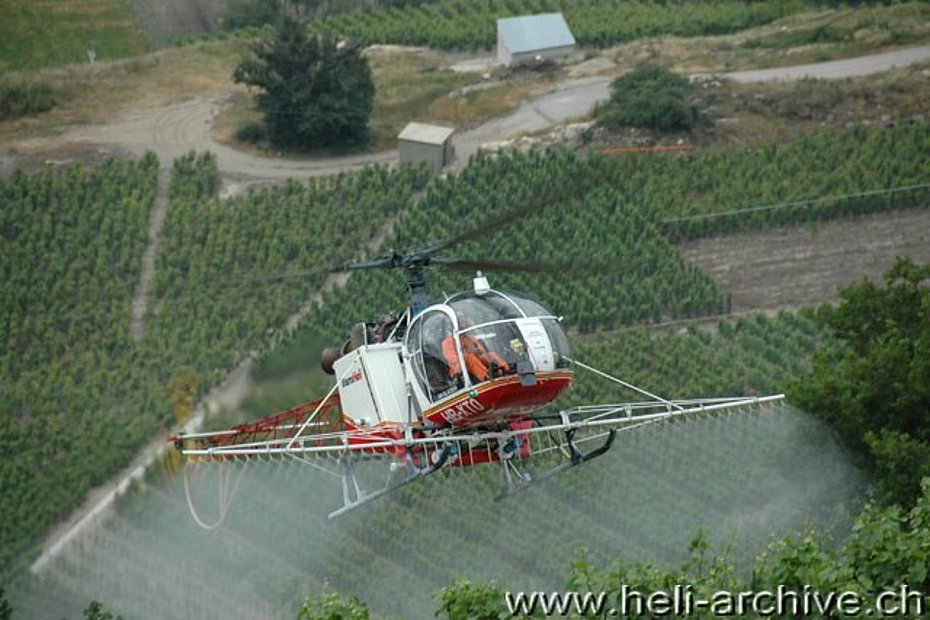
At least two generations of pilots appreciated the excellent flight qualities of this helicopter, without a shadow of a doubt one of the most popular in Switzerland. To date more than 80 have been in fact registered. This lead us to affirm that Switzerland has been one of the main users of this helicopter series in the world.
Among the Valaisan vineyards
In addition to the transport of persons and goods, Air Glaciers uses the Lama to spray vineyards. It is in this particular kind of air operation that you can admire the extraordinary maneuverability and great power of this aircraft.
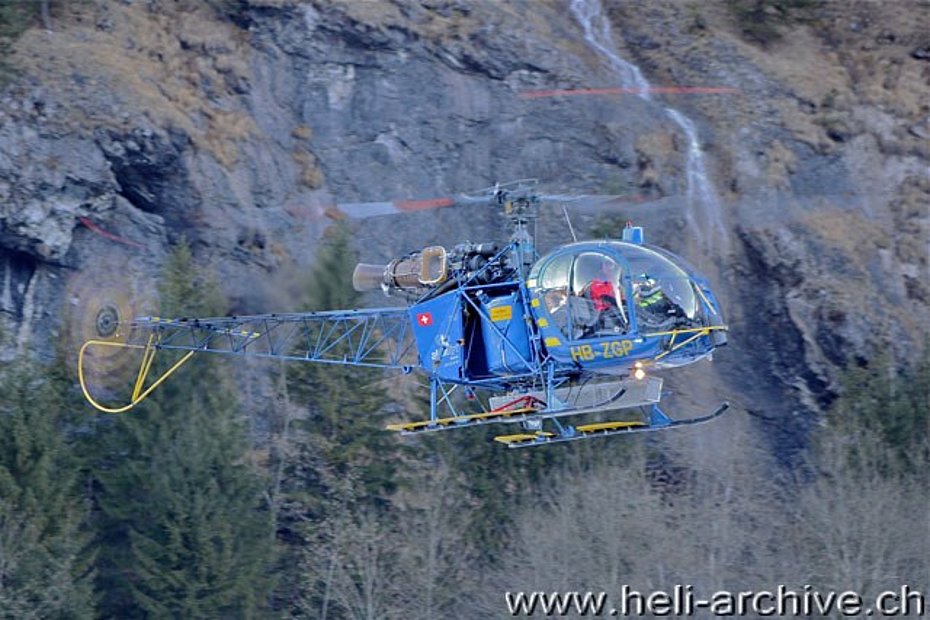
It is difficult to quantify with precision how many hours of work has accumulated the Lamas fleet in Switzerland, but at a guess we are probably on the order of some million hours!
As evidence of the reliability of the Turboméca Artouste IIIB1 are to be mentioned only a few accidents due to engine failure, at the base of which there are, in some cases, still human factors (errors by pilots or mechanics).
The Lama will continue to fly in Switzerland for a few years, so let's enjoy every occasion in which we can observe this extraordinary machine at work!
Among the most long-lived aircraft currently in service there is the HB-XEO (s/n 2321 b/y 1973) in service with Air Glaciers since 1975. The month of February 2013 it reached 16'000 hours of flight. This helicopter company currently is the largest civil user of this helicopter throughout the world.
Also to be mentioned Alpinlift Helikopter AG of Buochs/NW which purchased in 2004 what most likely will finish its career as the Lama with more flight hours of all. Its HB-ZGP s/n 2379 b/y 1974 until today logged approximately 23'200 hours of service and should end its long career with a total of 24'000 hours.
Among the first to fly with the Lama in Switzerland in 1971/72 were the pilots of Air Zermatt (Siegfried Stangier, Markus Burkhard), Air Glaciers (Fernand Martignoni and Bruno Bagnoud), Bohag (Günther Amann), Eliticino (Erwin Schafrath and Franz Giakomini).
Myths to debunk
Contrary to what is often claimed the SA 315B Lama is not the only helicopter capable of lifting a load equal to its own weight.
Interesting links
Have a look at the website of Pierre Gillard, a real Alouette 2/3 and Lama fan: http://www.alouettelama.com/home/index.html
Swiss Lamas at work - videos
Vertical Lama, vineyard spraying with the Lama of Air Glaciers 2008: https://www.youtube.com/watch?v=XAi3TRsSsBI
SA 315B Lama extreme flying - Bex/Switzerland 2007 - Climb in cabin with pilot Bernd Van Doornick: https://www.youtube.com/watch?v=ZkLwtCogci0
SA 315B Lama HB-XVL at work at Weissmies Mountain Hut: https://www.youtube.com/watch?v=8vbq3ncRFTI
Mountain Rescue - Air Zermatt SA 315B Lama: https://www.youtube.com/watch?v=ZfrtnxD5wJM
Inside the cabin of the Apinlift SA 315B Lama at work: https://www.youtube.com/watch?v=q23Uv1orJNk
Heli-Archive Bazzani 11/2013

